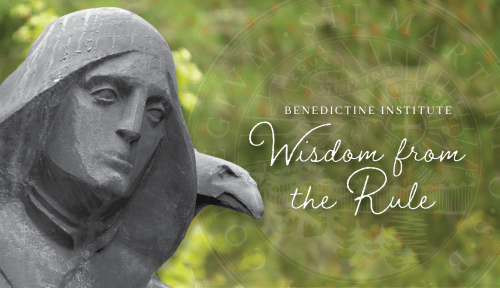Obedience – “Listen”
Are you exhausted? Seemingly always running low on energy?
It is not simply moralistic finger-wagging to recognize the reality of things that when we habitually place ourselves in the center, our desires and yearning for life, our desire to know, to innovate, to excel, to seek for happiness, these desires remain as robust as ever. However, with ourselves in the center, we walk around ourselves in a constant circle, leaving both ourselves and our desires frustrated and exhausted. As St. Bernard of Clairvaux describes it, by encircling around ourselves, we frustrate the natural end of our desires, which is not in constant “consumption, but in consummation”, in greater union with God and with others.
To you, who are both tired, exhausted and frustrated, St. Benedict has a ‘word’ for you, for all of us sinners, in fact: “It is high time for us to arise from our sleepiness.” (RB Prologue 8) Each and every day, will we listen not simply to ourselves, but to others? Will we listen? “If you hear his voice today, do not harden your hearts.” (Ps 95, 8; RB Prologue 10) But will we listen, listen well and act in accordance? In other words, will we be obedient?
The third and final Benedictine vow, obedience, is just as counter-cultural today as it was when St. Benedict first uttered these opening lines in his Prologue to the Rule:
“Listen [Obsculta] carefully, my son, to the master’s instructions, and attend to them with the ear of your heart. This is advice from a father who loves you; welcome it, and faithfully put it into practice. The labor of obedience will bring you back to him from whom you had drifted through the sloth of disobedience. This message of mine is for you, then, if you are ready to give up your own will, once and for all, and armed with the strong and noble weapons of obedience to do battle for the true King, Christ the Lord.” (RB Prologue 1-3)
If we are indeed ‘listening carefully’, these words should rouse us, like the sudden shock of a cold shower. That is, after all, partially their intended purpose. By listening carefully, Benedict is asking us: ‘To whom are we primarily listening to and being obedient? Is it my own will that I am primarily obedient to, or is it your will, O Lord? Benedict aims to shock us out of a certain tired, exhausted adherence to our own wills, constantly circling around ourselves. “Their law is what they like to do, whatever strikes their fancy. Anything they believe in and choose, they call holy; anything they dislike, they consider forbidden.” (RB 1, 8 -9)
But Benedict does not merely seek to shock, he also seeks to instruct. This is essential to obedience, which we will explore in greater depth for these next few weeks. Namely: ‘obedience’ is grounded not simply in passive adherence to rules and authority; rather, it is always coupled with listening and hearing. To obey, from the Latin, ob – audire, means to “hear or listen to”. This is why the first word in Benedict’s Rule is “Listen”. There is no real education apart from both humility (in recognizing, like Socrates, I know that I do not know) as well as obedience. Especially an education rooted not merely in the acquisition of data, of knowledge, but of wisdom. In and through obedience, Benedict teaches, we learn how to actually listen to others, not simply ourselves, and ultimately to the promptings of God.
To begin our meditations upon this central Benedictine vow, let us now consider how obedience is defined and lived out both within the monastery, and the university.
Obedience: a commitment to listening and consequent action
In monastic contexts…. Benedictine life is unthinkable without obedience, a value that cuts against the grain of much in contemporary life. It is often forgotten that the root of the word obedience is found in audire, “to listen.” When St. Benedict begins the Rule with the exhortation “Listen,” he emphasizes the stance of obedience required of all who seek wisdom. He asks for obedience not only to the spiritual head of the monastery, but to the other members of the community (RB 71:1-2). Each has something of value to say about true fullness of life. For the monastic, obedience is putting into practice what is learned by listening to the other “with the ear of the heart” (RB Prol. 1). Centuries of Benedictine experience show that such listening requires a willingness to submit to imperatives outside of the self, something that is never easy to do, but that is deeply rewarding.
In university contexts…. Teaching and learning are impossible without obedience, without listening to others with the awareness that no one possesses all truth, or knows everything worth knowing. In intellectual inquiry, obedience means respecting the integrity of disciplinary methods of study and maintaining fidelity to the evidence, wherever it leads. Obedience helps to form an intellectual community, drawing on a number of disciplines, respecting the methodologies proper to each. All members of a Benedictine educational institution are encouraged to work to understand and respect the viewpoints of others, to adhere to standards of excellence in thinking and communicating. Learning to listen well and respond deeply to others and the world is a prerequisite for growing in wisdom and it requires courage and perseverance.
Meditation:
“If you hear His voice today, do not harden your hearts”
(Ps 95, 7-8; RB Prologue 10)
Amen.



